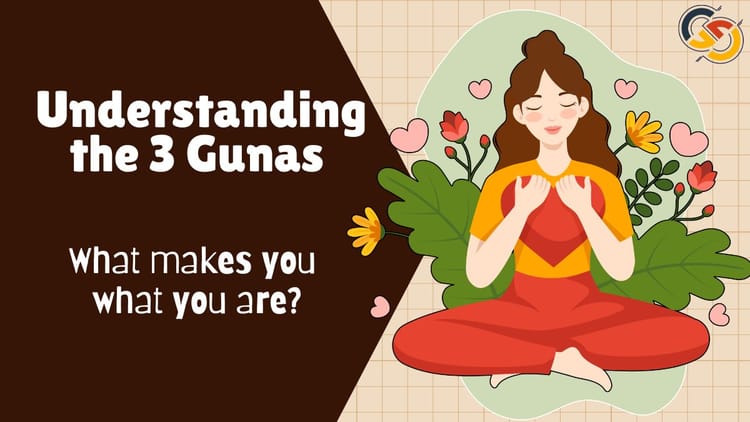Prana Shakti: The Key to Unlocking Your Inner Vitality

Understanding Prana Shakti
Prana Shakti is a fundamental concept in yoga and spiritual practices that unlocks one's true potential.
Prana Shakti, often called the "life force energy," is the vital essence that permeates all living beings and the universe. It is the driving force behind our physical, mental, and spiritual well-being, and understanding its significance can profoundly transform our lives.
This blog post will delve deep into the Prana Shakti concept, meaning, origins, and practical applications. We will examine how Prana Shakti manifests in various traditions, unravel its science and spirituality, and provide guidance on cultivating and enhancing your own Prana Shakti. Whether you are a seasoned practitioner or a curious beginner, this blog will offer valuable insights and techniques to help you harness the power of life force energy and embark on a journey of holistic growth and self-discovery.
The Essence of Prana Shakti: Definition and Meaning
At its core, Prana Shakti is the subtle energy that animates and sustains all life. The cosmic life force flows through our bodies, minds, and universe. The word "Prana" is derived from the Sanskrit root "pra," meaning "forth," and "an," meaning "to breathe." Thus, Prana is often associated with the breath, as it is through the breath that we draw in this vital energy.
On the other hand, Shakti represents the dynamic, creative power of the universe. The feminine principle of divine energy manifests in various forms, such as the power of transformation, healing, and creation. When Prana and Shakti combine, they give rise to the dynamic, pulsating life force that underlies all existence.
Different spiritual traditions offer unique interpretations and teachings about Prana Shakti. In yoga, Prana is considered one of the five sheaths or koshas that make up the human being, along with the physical body, mind, intellect, and bliss sheath. Yogic practices, such as Pranayama (breath control) and meditation, aim to cultivate and balance the flow of Prana within the body to achieve optimal health and spiritual growth.
Prana Shakti in Various Traditions
Life force energy is not limited to yoga and Hinduism; it is a universal principle recognized in various cultural contexts and spiritual practices worldwide. In Traditional Chinese Medicine, the life force energy is known as "chi" or "qi," which flows through meridians in the body. Acupuncture, tai chi, and qigong are practices that work with chi to promote health and well-being.
In Japan, the concept of "ki" is similar to Prana and chi and is a fundamental principle in practices like Reiki, a form of energy healing. In Hawaiian culture, "mana" is the spiritual energy that infuses all living things and is harnessed through hula and ho'oponopono (Hawaiian practice of reconciliation and forgiveness).
In Ayurveda, the ancient Indian holistic health system, Prana is considered the vital force that governs all physiological processes in the body. Ayurvedic practices, such as yoga, meditation, and herbal medicine, aim to balance and enhance the flow of Prana to promote physical, mental, and spiritual well-being.
Recognizing the commonalities and differences in how various traditions approach life force energy can deepen our understanding of Prana Shakti and its role in holistic health and spiritual growth.
The Science and Spirituality of Prana Shakti
While the concept of Prana Shakti is rooted in spiritual traditions, modern science has also begun to explore the idea of life force energy from an empirical perspective. Studies in bioenergetics and quantum physics have suggested the existence of subtle energy fields that interact with and influence living systems.
Research on practices like Reiki and qigong has shown measurable effects on physiological processes, such as heart rate variability and immune function, suggesting that working with life force energy can have tangible impacts on health and well-being.
From a spiritual perspective, Prana Shakti is the divine essence that connects all living beings to the greater cosmic whole. It bridges the physical and the metaphysical, the individual and the universal. Spiritual practices like yoga and meditation aim to cultivate a deep awareness of Prana Shakti, allowing practitioners to tap into the infinite energy and wisdom that underlies all existence.
Integrating the scientific and spiritual understanding of Prana Shakti can help us develop a more holistic approach to life. By recognizing the interconnectedness of our physical, mental, and spiritual well-being, we can make conscious choices that support the harmonious flow of life force energy within and around us.
Identifying and Cultivating Your Prana Shakti
Learning how to recognize and cultivate Prana Shakti's power within ourselves is essential to harnessing it. One of the most accessible ways to connect with Prana Shakti is through the breath. By bringing mindfulness to our breathing and practicing Pranayama techniques, we can develop a deeper awareness of the subtle energy flowing through our bodies.

Yoga asanas, or physical postures, are another powerful tool for cultivating Prana Shakti. As we move through various asanas, we can focus on directing the breath and awareness to specific areas of the body, promoting the balanced flow of Prana. Asanas that involve expansive movements, such as backbends and heart openers, are particularly effective in stimulating the flow of Prana.
Meditation is also a key practice for cultivating Prana Shakti. By sitting in stillness and turning our attention inward, we can begin to sense the subtle energy currents within us. Visualization techniques, such as imagining a luminous ball of energy at the heart center or picturing Prana flowing through the Nadis (energy channels), can help us connect more deeply with our inner life force.
As we continue to practice these techniques regularly, we may notice positive changes in our physical, mental, and emotional well-being. Many practitioners report increased vitality, mental clarity, and emotional balance from working with Prana Shakti. By sharing our personal stories of transformation, we can inspire others to embark on their journey of Prana Shakti cultivation.
Prana Shakti Healing: Anecdotes and Methods
The cultivation of Prana Shakti benefits our well-being and has the potential to facilitate healing in others. Prana Shakti healing involves channeling life force energy to restore balance and promote the body's natural healing processes.
One common method of Prana Shakti healing is Reiki. In a Reiki session, the practitioner places their hands on or near the recipient's body, allowing Prana Shakti to flow through them and into the recipient. Many people feel deep relaxation, warmth, and relief from physical and emotional discomfort during and after a Reiki session.
Benefits of Walking Barefoot.
Another powerful tool for Prana Shakti's healing is intentions and affirmations. By focusing our thoughts and words on healing and positive outcomes, we can direct the flow of Prana Shakti to support the healing process. This can be done through silent meditation, spoken affirmations, or even writing down intentions and placing them in a sacred space.
There are countless anecdotes of individuals experiencing profound healing through Prana Shakti practices. The transformative power of life force energy is well-documented, from alleviating chronic pain to releasing past traumas emotionally. By sharing these stories and exploring different methods of Prana Shakti healing, we can inspire others to tap into this innate source of wellness and vitality.
Enhancing Prana Shakti Through Lifestyle Choices
In addition to specific practices like yoga and meditation, our daily lifestyle choices play a significant role in cultivating and maintaining healthy levels of Prana Shakti. The foods we eat, the environments we inhabit, and the relationships we nurture all impact the flow of life force energy within us.
A diet rich in fresh, whole foods, particularly those that are organic and locally sourced, can help to nourish and revitalize our Prana Shakti. Ayurvedic traditions recommend eating sattvic foods, such as fruits, vegetables, whole grains, and legumes, which promote clarity, calmness, and vitality.

Regular exercise, especially practices emphasizing breath awareness and mindful movement, like yoga and tai chi, can help stimulate Prana Shakti's flow throughout the body. Engaging in activities that bring us joy and fulfillment, such as spending time in nature, creating art, or connecting with loved ones, can also enhance our overall well-being and vitality.
The environments we surround ourselves with can also impact our Prana Shakti. Clean, uncluttered spaces filled with natural light and fresh air can promote a sense of clarity and vitality. Incorporating elements like plants, crystals, and sacred objects into our living and working spaces can help create an atmosphere that supports positive energy flow.
By making conscious choices that prioritize our physical, mental, and emotional well-being, we can create a lifestyle that supports the cultivation and maintenance of strong, vibrant Prana Shakti.
Prana Shakti Kriyas and Mantras
In the yogic tradition, kriyas and mantras are powerful tools for activating and balancing Prana Shakti. Kriyas are physical and breathing exercises that cleanse and energize the body and mind. At the same time, mantras are sacred sounds or phrases that are repeated to focus the mind and cultivate specific qualities or intentions.
One simple yet effective kriya for enhancing Prana Shakti is Kapalabhati, or "Skull Shining Breath." To practice Kapalabhati, sit comfortably with a straight spine and take a deep breath. Then, exhale forcefully and quickly, drawing your belly button towards your spine. Continue this rapid, rhythmic breathing for 30 seconds to one minute, then allow your breath to return to normal. This kriya helps to clear stagnant energy, boost circulation, and invigorate the body and mind.
Another powerful kriya is Nadi Shodhana, or "Alternate Nostril Breathing." This practice involves inhaling and exhaling through each nostril alternately, using the thumb and ring finger to close off one nostril at a time gently. Nadi Shodhana helps balance the brain's left and right hemispheres, calm the mind, and promote overall equilibrium in the body and Prana Shakti.
Nadi Shodhan Pranayam practice (In Hindi)
Mantras can also be used to cultivate specific qualities of Prana Shakti. For example, the mantra "Om Shrim Maha Lakshmiyei Namaha" invokes the energy of abundance, prosperity, and divine feminine power. Repeating this mantra with intention and focus can help you draw these qualities into your life and enhance your Prana Shakti.
By incorporating kriyas and mantras into your daily practice, you can develop a deeper awareness of your Prana Shakti and learn to harness its power for personal growth and transformation.
Overcoming Obstacles in Prana Shakti Practice
As with any spiritual practice, cultivating Prana Shakti has its challenges. Practitioners may encounter common obstacles, including physical discomfort, mental distractions, and emotional blockages.
Physical discomfort, such as tightness or pain in the body, can arise during yoga asanas or meditation. Listening to your body and moving with compassion and patience is important. Modifying poses or props can help alleviate discomfort and deepen your practice.
Mental distractions, such as racing thoughts or difficulty focusing, are common challenges in Prana Shakti practices. Incorporating breathing awareness, mantra repetition, or visualization can help quiet the mind and cultivate inner stillness. It is also important to approach your practice with a sense of non-judgment and self-compassion, acknowledging that the mind will wander and gently guiding it back to the present moment.
Emotional blockages, such as unresolved traumas or limiting beliefs, can also hinder the flow of Prana Shakti. Practices like yoga nidra, or "yogic sleep," can help to release deep-seated tensions and promote emotional healing. Seeking the guidance of a qualified teacher or therapist can also provide support in working through emotional obstacles.

Ultimately, the key to overcoming obstacles in Prana Shakti practice is consistency, patience, and self-compassion. You can cultivate a deep and transformative relationship with your inner life force energy by showing up for yourself each day, even in small ways, and celebrating your progress.
Advanced Prana Shakti Practices: Kundalini and Beyond
For those who have established a strong foundation in Prana Shakti practices, exploring advanced techniques can offer a pathway to even deeper spiritual experiences and growth. One such advanced practice is the awakening of kundalini energy.
Kundalini is often described as a dormant spiritual energy coiled at the spine's base. Through specific practices, such as kundalini yoga and meditation, this energy can be awakened and guided upward through the body's chakras or energy centers. As kundalini rises, it brings profound spiritual experiences, increased awareness, and a sense of union with the divine.
However, it is important to approach the awakening of kundalini with caution and respect. The intense energy and experiences arising during kundalini awakening can be overwhelming and destabilizing if not properly guided and integrated. Working with a qualified teacher who can provide guidance and support throughout the process is essential.

Other advanced Prana Shakti practices may include techniques like chakra balancing, energy healing modalities like pranic healing, and advanced Pranayama practices like bhastrika and sukha purvaka. These practices can refine and deepen your awareness of Prana Shakti, allowing you to access even more subtle and powerful states of consciousness.
As with any advanced spiritual practice, it is important to approach these techniques with humility, discernment, and a strong foundation in self-care and self-awareness. By honoring your unique path and seeking guidance when needed, you can safely and effectively explore Prana Shakti's vast potential for personal and spiritual growth.
Measuring Prana Shakti Growth: Self-Assessment and Progress
As you continue cultivating Prana Shakti, having tools and methods for assessing your progress and setting goals for further growth can be helpful. While the subtle nature of Prana Shakti may not lend itself to precise measurement, there are several ways to gauge your development over time.
One simple method of self-assessment is to keep a journal of your experiences and observations during your Prana Shakti practices. Noting changes in your physical sensations, emotional states, and mental clarity can help you track your progress and identify areas for further exploration and growth.
Another useful tool is to work with an experienced teacher or mentor who can offer guidance and feedback on your practice. A skilled teacher can help you refine your techniques, overcome obstacles, and set appropriate goals for your unique path of Prana Shakti cultivation.
In addition to subjective measures of progress, some objective indicators can suggest growth in Prana Shakti. For example, increased sensitivity to subtle energies, improved physical health and vitality, enhanced mental clarity and focus, and a greater sense of inner peace and contentment can all be signs of deepening Prana Shakti.
Ultimately, the most important measure of progress in Prana Shakti practice is its positive impact on one's overall quality of life. By setting intentions and goals that align with one's values and aspirations and celebrating the small victories along the way, one can cultivate a sense of purpose and fulfillment in one's journey of Prana Shakti's growth.
Conclusion: The Journey of Prana Shakti Mastery
Cultivating Prana Shakti is a lifelong self-discovery, healing, and transformation journey. By tapping into the limitless reservoir of life force energy, we can access a profound source of wisdom, vitality, and creative potential.
As we continue on this path, it is important to approach our practice with patience, dedication, and an open heart. By honoring our unique journey and supporting one another, we can create a global community of Prana Shakti practitioners united in our commitment to personal and collective growth.
May this exploration of Prana Shakti inspire and empower you on your journey of self-realization and mastery. Remember, the power to transform your life and the world lies within you. Trust in the wisdom of your inner life force, and let it guide you towards your highest potential.
FAQs
Q: Can anyone learn to cultivate Prana Shakti, or do I need a specific spiritual or religious background?
A: Cultivating Prana Shakti is open to people of all backgrounds and belief systems. While the concept of Prana Shakti has its roots in Eastern spiritual traditions, the underlying principles of working with life force energy are universal. They can be adapted to suit individual needs and preferences.
Q: How long does it take to see results from Prana Shakti practices?
A: The timeframe for experiencing benefits from Prana Shakti practices can vary depending on factors such as the consistency and intensity of your practice, your constitution, and your specific goals. Some people may notice subtle shifts in their energy and well-being within a few weeks of regular practice, while others may take longer to experience noticeable changes. The key is approaching your practice with patience and commitment, trusting that the benefits will unfold in their own time.
Q: Can I practice Prana Shakti techniques alongside other spiritual or healing modalities?
A: Prana Shakti practices can seamlessly integrate with other spiritual or healing modalities. Many people find that incorporating Prana Shakti techniques enhances the effectiveness of their existing practices, such as yoga, meditation, reiki, or acupuncture. However, it's essential to listen to your body and intuition and to consult with qualified teachers or practitioners when combining modalities to ensure a safe and harmonious approach.
Q: Are there any specific dietary recommendations for supporting Prana Shakti cultivation?
A: While there are no strict dietary requirements for practicing Prana Shakti, many traditions recommend a sattvic diet, emphasizing pure, nourishing, and easily digestible foods. This typically includes whole grains, fresh fruits and vegetables, legumes, nuts, seeds, and herbal teas. Some practitioners also choose to limit or avoid stimulants like caffeine and alcohol, as well as processed or refined foods, to support the body's natural energy balance. Ultimately, the key is to listen to your body and make choices that promote feelings of vitality, clarity, and lightness.
Q: Can Prana Shakti practices be beneficial for managing stress and emotional well-being?
A: Prana Shakti practices can effectively manage stress and support emotional well-being. By cultivating a deeper awareness of your inner life force energy, you can learn to regulate your nervous system, release tension and blockages, and promote feelings of calm, balance, and resilience. Techniques such as Pranayama (breathing exercises), meditation, and yoga nidra (guided relaxation) are particularly helpful for reducing stress and promoting emotional healing. Regular practice can help you develop greater self-awareness, emotional regulation skills, and the ability to navigate life's challenges with greater ease and grace.
Q: How can I find a qualified teacher or community to support my Prana Shakti practice?
A: Finding a qualified teacher or supportive community can be invaluable on your Prana Shakti journey. One of the best ways to connect with teachers and fellow practitioners is to attend workshops, retreats, or classes focused on Prana Shakti or related practices like yoga and meditation. You can also search for local yoga studios, holistic health centers, or spiritual organizations that offer courses or events related to energy work or traditional healing modalities. Online resources, such as forums, social media groups, and virtual workshops, can also provide opportunities to connect with teachers and practitioners worldwide. When seeking a teacher, seek someone with extensive experience, a compassionate and empowering approach, and a commitment to ethical and responsible practice. Trust your instincts and take the time to find a teacher or community that resonates with your unique needs and goals.



